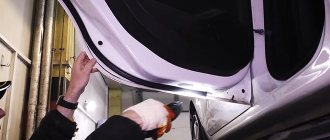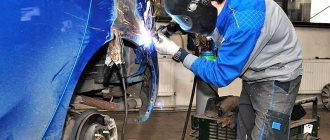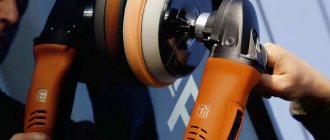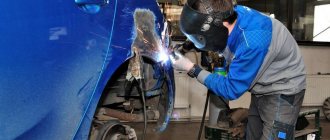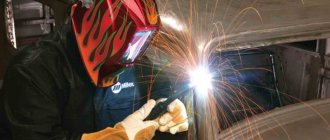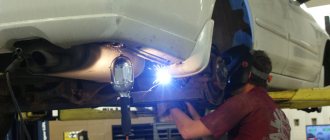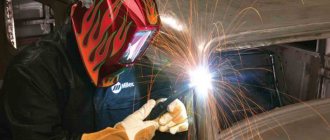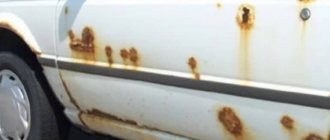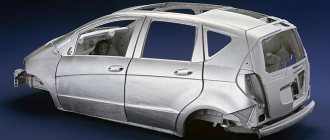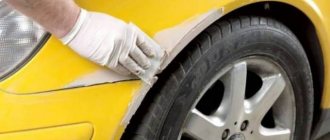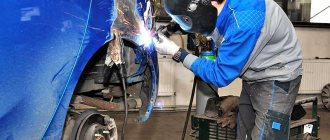Welding is very often used in car body repairs. However, simply connecting metal parts is not everything. Everything needs to be beautiful, neat and unnoticeable. In the video and article you will learn how to properly process welding seams.
The procedure for processing a weld seam will be considered using the example of a stand:
It is already neatly cut, without gaps and tacked:
Why can't you weld with a continuous seam?
Let's start with the fact that not all places cannot be welded with a continuous seam. Although, it is better not to use it everywhere. Pay attention, for example, to airplanes - there are no welds anywhere, there are rivets everywhere. A continuous seam will simply burst when twisting the metal.
In addition, when welding with a continuous seam, the part becomes very hot. In this case, not only the place that is heated is heated, but also all adjacent ones. The longer you cook, the wider the heating zone. Because of this, the metal can lead.
You need to cook in spots. At first, the distance between them should be approximately 5 cm. Then between them you need to weld another point. After that, one more point at a time between these new ones - until the seam becomes continuous, if you need it so much.
Attention! You need to cook in spots, be sure to let the metal cool. It is impossible to cool the metal artificially - otherwise it will shrink.
Welding and seam processing
1. Weld the material with short seams 1 cm long. There should be a distance of 1 cm between the seams. If the material “shoots”, it means you haven’t cleaned it well. If the welding surface is large, you can alternately weld sections from different sides.
2. Clean the seam with a grinder. After sanding, the seam should look something like this:
3. Apply epoxy primer It is not necessary to do it in a thick layer. The primer is applied to prevent the seam from oxidizing. If there is rust on the seam, it must be treated with acid primer. Epoxy primer has a very dense structure and protects the metal from moisture and air.
Let it dry for a day. Next, you can fill it with a 120- or 240-grit sandpaper to give the soil roughness.
Attention! The soil cannot be heated with a hairdryer; with its help you will dry only the top layer - nothing will dry under it.
4. Putty the weld seam
Cleaning the weld
The car body is its most expensive part. As long as the skeleton of a vehicle is alive, so long is its service life. All damage to the car body can be divided into the following types:
- Destruction by corrosion;
- Surface damage due to mechanical damage (including road accidents).
Each type of repair work has its own methodology. To combat corrosion, all kinds of primers are used, which reliably protect the metal from further destruction.
Mechanical damage and defects are most often welded. At this stage of repair work, cleaning the weld seam plays a key role in controlling the quality of the operations performed. Ideally, the junction of the parts should be inconspicuous and not attract attention.
Welding methods and equipment used
If the surface of the body is heavily corroded, welding is also used for repairs. The equipment that a master chooses to perform welding work can have different performance levels and ultimately determines the quality of the seam. Welding used in body repair can be of several types:
- Gas;
- Electric arc;
- Manual semi-automatic electric arc (environment with protective gas);
- Contact point.
Hobbyists repair their hardware using gas welding; this is the most affordable equipment for private use. Hand tools are not helpful in this matter, as the operation becomes very labor-intensive. Professional welders are skeptical about the use of manual electric arc welding, what about amateurs? Resistance welding is an expensive tool used by skilled craftsmen.
Welding the bottom
It is not recommended to weld the bottom with rolled ferrous metal, which is sold everywhere - it is highly susceptible to rust. Over time, such metal will transfer rust to the material to which it was welded, even if cleaned until clean.
A great solution is to use an old hood. Cut a section out of it and cook! It bends well, so it is very versatile. You weld the corners and tap in the middle, whatever you like - it can be given any shape. In addition, rust will not be transferred after welding. It is recommended to use metal from old foreign cars: hoods, fenders, roofs, etc.
Corrosion is when the surface of solids begins to deteriorate under the influence of chemical or electrochemical reactions or under the influence of the environment. It can appear on wood, plastic and concrete, and the metal from which cars are made begins to undergo this process already at the production stage of the vehicle.
This process continues during transportation and storage, but comes into full force during vehicle operation. Corrosion can completely destroy a car and turn iron into its oxide, which is popularly called rust. Many car owners mistakenly believe that once rust appears on the body surface, it is no longer possible to get rid of it and you just need to accept it and come to terms with it. This is often due to simple ignorance of modern technologies, including ways to combat this phenomenon. In particular, anti-corrosion treatment of the car yourself or at a service center will help prevent property damage. This method does not guarantee complete elimination of this phenomenon, but it significantly slows it down and helps maintain the vehicle in working order.
How to properly remove sealant
If the composition is applied incorrectly or if there is old sealant, the seam must be removed and the work done again. To clean hidden seams, use a mechanical method - remove a layer of material with a sharp spatula, knife, pumice stone, or sandpaper. To make sure you don’t scratch the base, you can use a chemical method - moisten the sealant with white spirit, and then use a knife to separate the softened compound. After preparing the base, you can apply a new layer of sealant, following the manufacturer's instructions.
Causes of corrosion on a car
All vehicles without exception are subject to this, regardless of which manufacturer they were produced by. To a lesser extent, it affects cars produced in a single copy on a personal order. As a rule, they are subjected to anti-corrosion treatment at the first stages of production. But even such measures are not able to completely rid the vehicle of this harmful phenomenon. With further operation of the car, especially in large cities and metropolitan areas, the process of destruction of metal by rust receives favorable conditions for its development. The acceleration of corrosion is facilitated by small scratches and chips that a car can receive when driving on a poor quality road.
FANCLUB-VW-BUS.RU
VW minibus fan club
- Unanswered topics
- Active topics
- Search
- our team
What is the technology for processing weld seams?
What is the technology for processing weld seams?
Posted by allann » 12 Oct 2012, 09:37
Hello. Maybe this has already been discussed, but I didn’t find this in the topics. If you can, stay on topic. You don’t need to watch the whole video, but only from the 9th minute.
https://youtu.be/
After welding and cleaning, it seems to be coated with zinc. What does he apply before galvanizing? What kind of zinc? What does he stick the spatula into later when he smooths out the zinc snot?
If anyone has encountered this method, can you please share the information? Is it worth using this method or can it be simpler. It is necessary to process several areas of the body where the pieces are welded. Thank you
Re: What kind of technology for processing weld seams?
Post by ksenon17 » 12 Oct 2012, 09:43
Re: What kind of technology for processing weld seams?
Post by Yurgen » Oct 12, 2012, 10:20 am
Re: What kind of technology for processing weld seams?
Post by Mikhail Cossack » Oct 12, 2012, 10:29 am
Re: What kind of technology for processing weld seams?
Post by vfrc » 12 Oct 2012, 11:23
Re: What kind of technology for processing weld seams?
Post by Mikhail Cossack » 12 Oct 2012, 13:26
Re: What kind of technology for processing weld seams?
Post by Dimon » Oct 12, 2012, 01:47 pm
Also how it is used, how the cardon was opened, so this duck went to the people that the Germans galvanized right up to the roof
And by the way, under the rubber band of my windshield there is tin and it’s holding, and I don’t remember whether the rear time was pressing, in general it was just primer with paint, and after seven years the rust began to come out.
Re: What kind of technology for processing weld seams?
Post by Mikhail Cossack » 12 Oct 2012, 17:11
Re: What kind of technology for processing weld seams?
Posted by allann » 12 Oct 2012, 18:44
Re: What kind of technology for processing weld seams?
Post by vfrc » 12 Oct 2012, 19:19
Re: What kind of technology for processing weld seams?
Post by Mikhail Cossack » 12 Oct 2012, 19:57
Re: What kind of technology for processing weld seams?
Post by ksenon17 » 12 Oct 2012, 20:00
Re: What kind of technology for processing weld seams?
Posted by allann » 12 Oct 2012, 21:41
electrochemical is probably galvanization, but in May cases it is impossible. This is what the German smears with before applying. I don’t even really understand where to get such zinc rods (if there is zinc at all), but it seems that it gets into the gaps, plus it won’t bounce off like putty where it will be thicker (after welding the pieces, you need to level them in a thicker layer).
We begin the car processing process
Properly performed anti-corrosion treatment of a car with your own hands will not harm the car, because the layer of application of any component for protection must be of a minimum thickness. And its application to the body or assembly should be done extremely carefully. Before you begin measures to protect your car from corrosion phenomena, you should carry out preparatory measures:
- Free up space in the trunk and remove the sound insulation layer from it.
- Then remove the mats and insulation under the hood, that is, all coverings that can prevent you from reaching the body surface.
- Carefully remove any swollen paint and clean off any rusty areas.
- Rinse the car thoroughly, paying special attention to hard-to-reach areas. Professionals recommend washing your car before the upcoming anti-corrosion treatment in three stages with water at a temperature of at least 70 degrees. First, it will be enough to pour plenty of water on the car. After this, all areas should be thoroughly washed with detergents. And at the end, rinse the entire car thoroughly.
- Wipe the body dry to remove any remaining water with a soft cloth.
- The thresholds should be washed and dried especially carefully.
- Some rust preventatives can corrode rubber components, so remove any rubber that may be in contact.
- Cover the seats in the cabin with cellophane or thick rags so as not to accidentally stain them during the work.
- The pedals and the floor underneath them should also be carefully covered. The resulting coating is quite slippery and no one wants their soles to slide on the pedals.
Now you can begin preparing tools and materials for work. Regardless of the complexity of the repair, you will need:
- the anti-corrosion agent itself;
- drill or screwdriver;
- spray;
- paint brush;
- metal drill;
- simple plumbing tools
- rags;
- plugs for holes of different sizes.
In most cases, car owners carry out selective anti-rust treatment of those body elements that are most vulnerable to harmful influences - the underbody of the car and wheel arches. In addition, it is advisable to protect with an anti-corrosion mixture the places where moisture accumulates the most, such as the car pillars, its sills, welding points and joints on body bends.
Complete processing consists of several stages. The bottom and wheel arches are subject to a two-layer application of the mixture. It is mandatory to treat hidden areas of the car, its welds and joints on bends. The surfaces inside the hood and trunk are treated in one layer.
How to treat welding seams on a car
Welds are responsible for the integrity of the metal structure. In particular, the connection must be strong enough, resistant to rust and moisture. Weld seam processing is designed to ensure the fulfillment of these tasks.
- Processing methods
- Heat treatment
- Heat treatment equipment
- Heat treatment methods
- Mechanical restoration
- Chemical treatment
Processing methods
There are three methods by which welded joints are protected:
- Heat treatment. Thanks to this method, it is possible to remove residual stresses in the material resulting from welding work. Heat treatment is carried out using one of two technologies: local, when only the connection itself is heated or cooled, or general - the entire part is subject to temperature treatment.
- Mechanical restoration. In this case, the task is to remove slag residues and check the reliability of the connection. A typical example of machining is tapping a seam with a hammer or sanding it. If the slag is not removed, corrosion may develop.
- Chemical treatment. Applying protective coatings to joints is one of the ways to combat corrosion processes. The most affordable option for chemical protection is treating the seam with a primer paint and varnish material.
Below we will look at weld protection technologies in more detail.
Heat treatment
In addition to reducing residual stresses in the metal, heat treatment allows you to achieve the following goals:
- make the structure of the seam and heat-affected zones more adapted to external factors;
- optimize the physical and operational properties of the material, in particular, increase rust resistance, heat resistance, etc.
Heat treatment of welded joints involves heating the welded joint or the entire metal to a given temperature for a certain time. Next comes artificial cooling, which is also carried out according to a certain scenario.
Heat treatment equipment
Four types of technological equipment can be used for heat treatment of joints:
- Induction devices. Induction heating is often used during pipeline installation. The essence of this method is the use of copper inductors, including multi-core air-cooled copper cable. When installing the inductor on the pipeline, the distance between the pipe and the inductor must be taken into account. The general rule is: the larger the gap between objects, the worse the equipment's power is used.
- Flexible resistance heaters. This method is considered one of the most convenient and affordable methods for processing welds.
- Muffle furnaces. When working with this type of equipment, special attention must be paid to the uniform heating of the connection, which is achieved by non-centered installation of the part in the furnace.
- Heating using gas-flame equipment. When using gas flame heating, welding and special multi-flame gas burners are used. Gas heaters produce thermal energy resulting from the combustion of a mixture of combustible gas and oxygen.
Don't miss: How to create a Venetian plaster effect using paints
Heating equipment is selected based on installation conditions, availability of a particular type of device and other circumstances. Heating equipment must meet certain requirements: be clearly connected to the welds, not have too much mass, and ensure uniform heating of the joint both in width and length.
To reduce heat loss, all kinds of heat insulators are used when heat treating welded joints.
Thermal insulation must be heat-resistant with low thermal conductivity, durable, but at the same time flexible, wear-resistant and safe to use.
Heat treatment methods
Several methods of heat treatment of welded joints are known:
- Preheating. It is used both before welding and during welding of parts. This type of heat treatment is used when welding structures made of low-carbon steel. The metal warms up to 150-200 degrees Celsius.
- High holiday. The technique consists of heating the material to 650-750 degrees Celsius (the specific temperature depends on the type of steel). The temperature is maintained for 5 hours. The technology makes it possible to reduce stress by 80%, as well as increase the material’s resistance to mechanical stress and increase its elasticity.
- Normalization. Applicable to carbon and low-alloy steel grades. Such heat treatment of the compound is carried out at temperatures from 950 degrees Celsius. At the end of heating, exposure and cooling are carried out under ambient conditions. Normalization makes it possible to reduce the grain size of the metal, reduce stress, and also increases the strength of the weld.
- Austenization. It is the hardening of a welded joint by heating it to a temperature of 1070 degrees and above. The part is heated for 60 minutes, and then rapid artificial cooling is performed. The technique is widely used for hardening austenitic steels. The result of austenitization is increased elasticity of the welded joint.
- Stabilization. Stabilizing annealing differs from austenitization by a lower temperature and a shorter period of holding the metal.
- Thermal rest. The technology consists of heating the weld to 250-300 degrees Celsius. Then the metal is kept in a heated state. As a result of the procedure, the level of diffuse hydrogen in the welded joint is reduced and internal stresses are reduced.
The structure of the weld during heat treatment
The choice of the method by which heat treatment of welded joints will be carried out depends on the physical and chemical characteristics of the steel (determined by its grade). Fulfillment of technological requirements is of particular importance, otherwise the quality of the welded joint will deteriorate.
Key parameters to consider when performing local heat treatment:
- width of the heated area;
- uniform heating across the wall thickness and width of the heated area;
- holding period;
- cooling intensity.
Do-it-yourself anti-corrosion treatment of a car is considered complete
Of course, the work done will not give you a guarantee that doing this procedure just once will be enough. The coating will deteriorate over time and there will be a need to apply a new one. But carefully applied mastic will protect your car from corrosion for a long time. The service life of the anti-corrosion mixture will depend on many conditions, including the quality of the mixture used, compliance with the technological processes for its application, the initial condition of the car and its operating conditions.
The urgency of carrying out work to protect your car is explained by the speed of the process of destruction of metal by rust, which is facilitated by the increased humidity of air masses in certain regions and the use of chemical reagents on urban roads. Nowadays, even when buying a car at a prestigious dealership, experts recommend treating the body with an anti-corrosive agent. This is due to the fact that not all manufacturers pay due attention to this important issue. And car owners have to do the treatment themselves or at a car service center. However, not everyone can afford to entrust this work to service technicians, because this is a rather expensive procedure, and, again, no one can vouch for the quality.
Moskvich 2141 BTR-2, Vozrozhdenie › Logbook › Day 36. Guide to protecting welds
For the last stage of welding work (welding the false thresholds from the inside of the cabin), it is necessary to process the half-threshold joint that will be forever closed by the cavity of the false threshold.
Therefore, instructions on how to protect welding seams according to science
We see a seam from a week ago.
Therefore, I use a brush attachment on a grinder and clean off all the oxide. Then I blow the seam with a vacuum cleaner (hose on the exhaust). It's faster than dragging the blower from the compressor)
I blow it again until the solvent dries and cover it with reactive (tapping) primer. I blew it out with a paint spray, although you can use a brush (but it will take up much more soil)
Then I heat the hand (suture) sealant in a water bath. We use a good one, dear. The cheap one will fall off in 4-5 years like a factory one from Moscow. Then I apply it to the seam with a brush.
It turns out like this:
Next you need to dry it, follow the instructions for drying time. It's cold in my garage, so I leave it to dry overnight.
In the morning you need to cover the resulting
After this procedure, processing of the weld seam is completed. The seam becomes almost eternal and will last the entire service life of the car.
Moskvich 2141 1992, petrol engine 1.5 l., 72 l. p., front drive, manual transmission — body repair
Cars for sale
Moskvich 2141, 1990
Moskvich 2141, 1998
Moskvich 2141, 1993
Moskvich 2141, 1997
Comments 51
Well, how is the seam doing after 6 years?)
Why is epoxy primer applied over joint compound and not vice versa?
I have the same question :)
So, how are the stitches holding up after 4 years?)
I support it, it’s also interesting!
In Steam Punk style)
PLEASE TELL ME, THE FRONT SIDE NEEDS TO BE WELDED... ACCORDING TO THE IDEA THERE WILL BE NO SEALANT, THERE WILL BE A WHOLE SEAM (WELDING THE ARCH) WHAT IS THE BETTER PROTECTION? ALL I FOUND WAS PASTE WITH TIN FOR TINNING. THEY Suggest THAT YOU CAN PROCESS A PASTE FOR SOLDERING FOOD PIPES, IT'S WITH SILVER... I WANT THE SEAM NOT TO RUST ANYMORE... IS THIS POSSIBLE?
it won’t even work with a spatula if you protect the cooked food from the inside from moisture and air
As I understand it, if the metal is tinned on all sides and closed, then everything will be fine?
the weld seam is where the threshold (stiffening rib) is, if it suddenly gets jammed, is it worth bothering with repairs or is it easier to treat with chemicals?
success and not a nail or a rod!
Tell me, what did you use to treat the external welds?
Types of body sealants and application
Let's look at the main types that are used in car body repair.
1. Seam sealant in a tube (cartridge) 300 ml. This type is probably the most common and frequently used. This is a one-component composition mainly intended for sealing seam joints. This type is the best sealant for creating a perfect seam. To use it, you need a special sealant gun.
Such pistols are available both mechanical and pneumatic.
Car sealant in tubes is used for sealing rolled seams, internal parts of doors, hood, trunk, and in the engine compartment. They come in different colors, white, black, beige, gray, to create the optimal substrate.
2. Seam sealant under the brush. This type is produced in 1 kilogram jars; it is also a one-component composition, which is intended for application with a brush. It is excellent for gluing metal parts, for filling butt and weld seams
Automotive brush seam sealant is often used for connecting parts of the luggage compartment, engine compartment, under bumper area and other invisible elements. It provides reliable protection against moisture and corrosion. Also has different colors, white, black, beige, gray.
3. Automotive sealant tape. Seam tape for creating a perfectly even seam. It has an adhesive base, is lightweight and very easy to use. Does not require drying and can be painted immediately.
4. It is also worth paying attention to the car sealant in a tube (150 ml). It is suitable for some small jobs. Has the same characteristics and functions as above. Available in various colors: white, black, gray, beige.
For example, consider several popular brands and types.
Sealant selection criteria
Automotive stores sell a variety of sealants: for hatches, bodies, and pipe connections. They differ in terms of heat resistance, elasticity, and service life. The highest quality, but most expensive, are professional products, which are sold in large containers and are usually used in auto repair shops.
For home use, sealants are purchased in tubes of suitable volume (40-200 g). If you decide to give preference to the latter option, it is better to purchase the material in an aluminum tube: it fully retains its properties throughout its shelf life. Cheaper products are presented in plastic tubes, but when purchasing, be sure to check the remaining shelf life: it should be at least 6 months.
Some sealants have a convenient dispenser tip: they can be easily applied even to surfaces in hard-to-reach areas. Body sealant in a cartridge requires the additional purchase of a glue gun, without which you will not be able to use the product.
Body 999 sealant
Body 999 sealant is very popular and can be found in almost every painting store.
Bodysuit 999 is available in almost all of the above options. This is a 150 ml tube, 300 ml cartridge. and a 1 liter jar. Consists of a rubber base and various resins. Used to seal metal and protect it from environmental influences. Retains its elasticity for a long time. Virtually no shrinkage. Even with a very thick layer it does not crack and has excellent adhesion to the surface.
Surfaces to be applied:
- Steel
- Old paintwork
The product is ready for application and does not require additional dilution. After drying, it can be painted with any type of enamel. Apply exclusively to the internal parts of the car.
How to use sealant correctly
The application of auto sealants has its own nuances, and to obtain a high-quality result, the following rules must be strictly followed:
- Before work, thoroughly clean the surface, remove rust, degrease,
- To enhance adhesion, clean the substrate with red Scotch Brite,
- carry out priming with special primers for metal, if this measure is indicated in the instructions for the sealant.
To seal the seams, you need to prepare the composition: if necessary, dilute or print the tube, insert the cartridge into the gun, open the package with tape. You may also need a spatula or brush for the job. Afterwards, you need to apply the composition to the area of the future seam, acting at the same speed along its entire length - this will help make the joint smooth, like a factory one.
Excess sealant should be removed immediately with a spatula or your fingers. If the composition is very sticky, you can sprinkle it with a little water. In the future, it is allowed to paint the seam, but only after the time specified by the manufacturer has elapsed. This usually becomes possible after the sealant has completely polymerized.
3M sealant for car
3M sealants have long proven themselves in body repair. They have a large range of materials for various needs. Consider 3M 08684. This is a one-component polyurethane composition in gray (also available in black and white). Designed for processing seams around doors, joining panels, car floors, etc.
This 3M polyurethane body sealant has the following characteristics:
- Good to apply
- Doesn't spread
- Dries quickly
- After drying it has high hardness and elasticity
- Dries in harsh conditions (humidity, low temperature)
There are also 3M automotive body sealants for weld seams (welding seams), but as practice shows, it is still recommended to first treat them with acidic primer or epoxy.
Sealant application technology
Before applying weld sealant to vehicle parts, the following preparations are performed:
- The area to be repaired is cleaned of dirt and dried. The operation cannot be performed with sandpaper, as it will leave scratches.
- To improve adhesion, sanding with red Scotch Brite is allowed.
- If necessary, the surface of the welded joint is leveled with a two-component primer.
- Degreasing is carried out with anti-silicone.
The composition can be applied through a tip attached to the tube, but to obtain an even coating it is better to use a pneumatic gun. To control and regulate the process, a pressure gauge is installed. In order for the seam to be the required width without deviations to the sides, you need to use a special petal (butterfly) as a support. Sealant deposits are removed with a finger or a rubber spatula. If the mixture sticks and stretches, it is sprayed with anti-silicone.
Popular Products
When choosing, preference should be given to seam sealants for cars from trusted manufacturers, so that you don’t have to redo the work in a couple of days. According to survey results, these include:
- Merbenit XS55 creates a highly durable elastic coating. Due to its high adhesion, it can withstand prolonged exposure to vibration and mechanical loads without damage. Not afraid of salt water, vagaries of weather and aggressive environments. No smell, coloring allowed.
- BODY 999 is a long lasting sealant that dries with minimal shrinkage. It does not crack when applied in a thick layer, without spreading even on vertical planes. Painting after drying is not prohibited. However, it does not tolerate ultraviolet radiation, so it is used for repairs in places where sunlight does not reach.
- 3M 08537 is used as a joint sealant for the treatment of joints and welded joints in automobiles. The composition is resistant to moisture and oils, elastic, designed for application with a brush in a thin layer.
Seam sealants have high adhesion, which allows them to connect non-critical car parts without welding. For temporary tacking, the composition is applied to one of them. For a strong connection on both. Sealants are also used as seals at the joints of hoses and tubes. Therefore, experienced drivers, especially on long trips, always have them at hand.
Tools and materials
To weld the bottom, in addition to welding equipment, you will need consumables. When choosing which metal to cook with, you need to consider two points:
- thin steel is more difficult to weld; experience is needed to choose a temperature regime that eliminates the risk of burns;
- Thick iron is more difficult to process.
The patches are made of metal with a thickness of 1 to 2 mm - these are the optimal parameters.
What you will need when working:
- welding machine, when working with manual arc welding you will need thin electrodes, maximum size 1.6 mm; for a semi-automatic machine you need copper wire and carbon dioxide;
- grinder with cutting and grinding attachments;
- gas welding plus carbide, oxygen for cleaning rust from hard-to-reach places;
- regular or electric metal shears, they are used to cut out patches;
- electric drill;
- a hammer, used to tap the bottom of the car to identify defects;
- a chisel or hammer drill to remove sound insulation;
- screwdriver or screwdriver.
The bottom is viewed on an overpass or in an inspection hole in good lighting. The metal is tapped with a hammer to test its strength. A lift will be needed to provide access to the damaged areas.
You will need a rust converter, soundproofing coatings; anti-corrosion compounds; primer for metal; solvent or other degreasing compound.
Unexpected expenses
It is necessary to provide for the purchase of spare parts. Their necessity is determined after inspecting the car. During repair work, dilapidated elements of the machine are replaced:
- rotten and bent sills, they are removed first, and during installation they control the geometry of the body;
- floor spars;
- floor panels, they are mounted from below;
- brake and fuel pipes stuck to the metal.
Sometimes other elements of the machine require replacement. It is better not to purchase spare parts for future use; they may not be needed.
Types of anti-gravel for car thresholds
The number of anti-corrosion treatment agents for car sills is large. By and large, they are not much different from each other.
Means for protecting car thresholds from rust can be divided into several groups:
1. Period of use.
- permanent protection;
- temporary protection;
2.Packaging.
- aerosol can ready for use;
- aerosol can for a special gun;
- metal cans;
- plastic containers.
3.Color.
- transparent;
- white;
- black;
- gray;
- color.
4.Additional effects.
- containing a rust converter;
- anti-corrosion substances;
- increased adhesion;
- enhanced strength.
How to seal/treat seams after welding?
#1 zorin_andrey
#2 andsv
#3 VALERY TYUMEN
Hello! In general, I’m slowly mastering semi-automatic welding - I’m digesting the bottom, sills, arches, etc. on the trouper. After half an hour, the freshly cooked leaf begins to turn yellow and brown - it oxidizes. I treat it with a phosphating liquid - which removes rust and protects the metal from further corrosion. But the essence of the question is this: how to treat it, seal it, etc. the seams themselves. The welding there is more like spot welding (with an interval of 1 cm) and there are small cavities in the seams between them. Just cover it with automotive plaster or are there more reliable/correct methods. Please tell me.
- Top
#4 2.2
Hello! In general, I’m slowly mastering semi-automatic welding - I’m digesting the bottom, sills, arches, etc. on the trouper. After half an hour, the freshly cooked leaf begins to turn yellow and brown - it oxidizes. I treat it with a phosphating liquid - which removes rust and protects the metal from further corrosion. But the essence of the question is this: how to treat it, seal it, etc. the seams themselves. The welding there is more like spot welding (with an interval of 1 cm) and there are small cavities in the seams between them. Just cover it with automotive plaster or are there more reliable/correct methods. Please tell me.
- Top
#5 Peter Tiger
Hello! In general, I’m slowly mastering semi-automatic welding - I’m digesting the bottom, sills, arches, etc. on the trouper. After half an hour, the freshly cooked leaf begins to turn yellow and brown - it oxidizes. I treat it with a phosphating liquid - which removes rust and protects the metal from further corrosion. But the essence of the question is this: how to treat it, seal it, etc. the seams themselves. The welding there is more like spot welding (with an interval of 1 cm) and there are small cavities in the seams between them. Just cover it with automotive plaster or are there more reliable/correct methods. Please tell me.
- Top
#6 Alex Gazovoz
- Top
#7 SSM
- Top
#8 zorin_andrey
- Top
#9 Frosik
. Either Rust-Stop has screwed up, or it’s just g..but. After a year of observation, I can confidently say that I have tested it myself.
- Top
#10 alekseyka77
Hello! In general, I’m slowly mastering semi-automatic welding - I’m digesting the bottom, sills, arches, etc. on the trouper. After half an hour, the freshly cooked leaf begins to turn yellow and brown - it oxidizes. I treat it with a phosphating liquid - which removes rust and protects the metal from further corrosion. But the essence of the question is this: how to treat it, seal it, etc. the seams themselves. The welding there is more like spot welding (with an interval of 1 cm) and there are small cavities in the seams between them. Just cover it with automotive plaster or are there more reliable/correct methods. Please tell me.
For side members and arches
Anticorrosive for hidden cavities should be more elastic and, preferably, have good sound insulation. In this regard, the compositions are not interchangeable.
Dinitrol
Cool anti-corrosion coating from Dinitrol. Drivers loved him for:
- Easy to apply. On sale there are cans with a spray and a gun for treating hidden cavities of the car body.
- Penetrating properties. "Dinitrol" penetrates into every crack, so it is almost impossible to tear it off. By the way, the manufacturer recommends applying subsequent layers directly to the old ones.
- Corrosion inhibitors. There is no need to clean off rust spots before application.
Liqui Moly Hohlraum-Versiegelung
How to treat external car sills against corrosion?
Car painters recommend this product from Liqui Moly. The main feature is powerful penetrating properties and ease of application.
But it is better to treat car arches using another means. Firstly, the film is quickly erased by gravel. Secondly, the sound insulation properties are mediocre.
Tectyl
Universal anti-corrosion material for the body, arches and side members. Sold in 600 ml cans, which is enough for the entire car.
Dries quickly and penetrates even the smallest cracks. It preserves rust spots well, so you don’t even need to clean them. In addition, the product lasts about 3 years without updating!
"Movil"
The good old Movil is suitable for treating cavities on the car body. Today, this is the most affordable product on the car market.
It has average adhesion, heat resistance and durability. There are no rust inhibitors in the composition, so cleaning is required.
Nanoprotech "Super Anticorrosive"
Mid-price anti-corrosion agent with a cool feature - regular laboratory tests. The adhesion of the product is excellent, as is the protective film - it is not afraid of gravel or sand.
It is used economically, even though the volume is small. The only drawback of the product is that it is not regularly topped up. 50 ml of anticorrosive, which with a volume of 210 ml is a catastrophic shortage.
Sealant for sealing car welds
If the joints after repair are not protected from moisture, they will quickly rust and the work will have to be done again. To prevent the connections from coming into contact with the external environment, they are treated with a sealant for car welds. Manufacturers produce compounds for various purposes, so before going to the store, it is useful to familiarize yourself with their characteristics.
